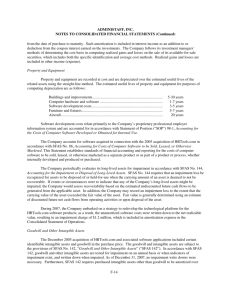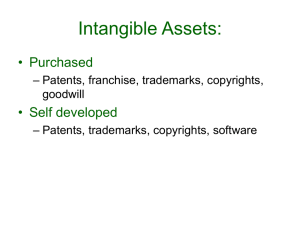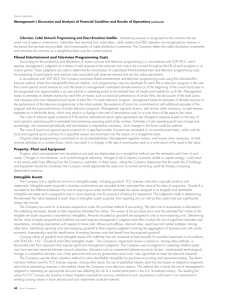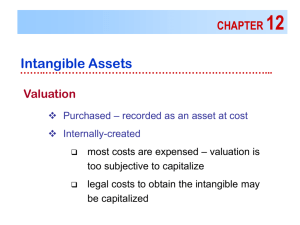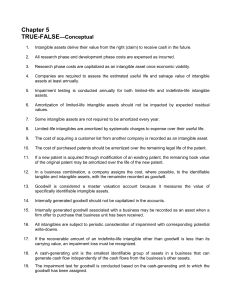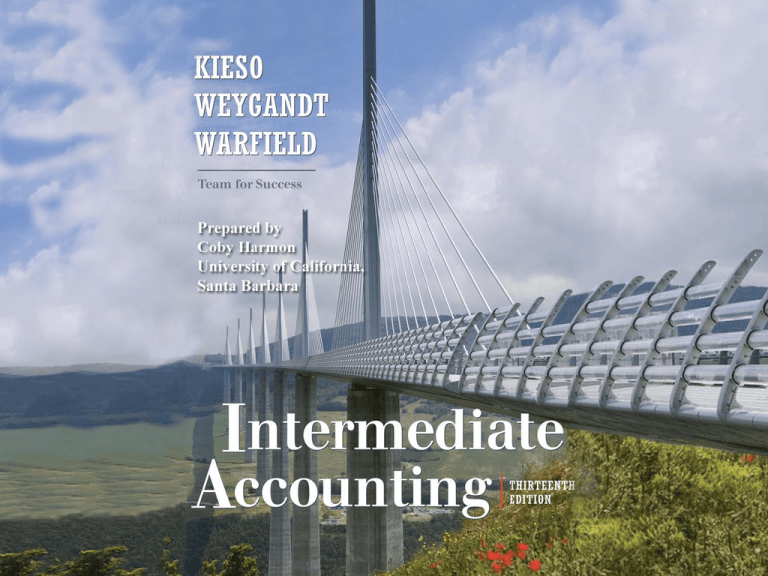
Chapter
12-1
CHAPTER
INTANGIBLE
12
ASSETS
Intermediate Accounting
13th Edition
Kieso, Weygandt, and Warfield
Chapter
12-2
Learning Objectives
1.
Describe the characteristics of intangible assets.
2.
Identify the costs to include in the initial valuation of intangible
assets.
3.
Explain the procedure for amortizing intangible assets.
4.
Describe the types of intangible assets.
5.
Explain the conceptual issues related to goodwill.
6.
Describe the accounting procedures for recording goodwill.
7.
Explain the accounting issues related to intangible-asset
impairments.
8.
Identify the conceptual issues related to research and
development costs.
9.
Describe the accounting for research and development and
similar costs.
10. Indicate the presentation of intangible assets and related items.
Chapter
12-3
Intangible Assets
Intangible Asset
Issues
Types of
Intangibles
Impairment of
Intangibles
Research and
Development
Costs
Presentation of
Intangibles and
Related Items
Characteristic
s
Marketingrelated
Limited-life
intangibles
Identifying
R&D
Intangible
assets
Valuation
Customerrelated
Indefinite-life
intangibles
other than
goodwill
Accounting for
R&D
R&D costs
Amortization
Artisticrelated
Contractrelated
Technologyrelated
Goodwill
Chapter
12-4
Goodwill
Summary
Similar costs
Conceptual
questions
Intangible Asset Issues
Characteristics
Two Main Characteristics:
(1) They lack physical existence.
(2) They are not financial instruments.
Normally classified as long-term asset.
Common types of intangibles:
Patents
Trademarks or trade names
Copyrights
Goodwill
Franchises or licenses
Chapter
12-5
LO 1 Describe the characteristics of intangible assets.
Intangible Asset Issues
Valuation
Purchased Intangibles:
Recorded at cost.
Includes all costs necessary to make the intangible
asset ready for its intended use.
Internally Created Intangibles:
Generally expensed.
Only capitalize direct costs incurred in developing the
intangible, such as legal costs.
Chapter
12-6
LO 2 Identify the costs to include in the initial valuation of intangible assets.
Intangible Asset Issues
Amortization of Intangibles
Limited-Life Intangibles:
Amortize to expense.
Credit asset account or accumulated amortization.
Indefinite-Life Intangibles:
No foreseeable limit on time the asset is expected to
provide cash flows.
No amortization.
Chapter
12-7
LO 3 Explain the procedure for amortizing intangible assets.
Intangible Asset Issues
Accounting for Intangibles
Illustration 12-1
Chapter
12-8
LO 3 Explain the procedure for amortizing intangible assets.
Types of Intangibles
Six Major Categories:
(1) Marketing-related.
(2) Customer-related.
(3) Artistic-related.
(4) Contract-related.
(5) Technology-related.
(6) Goodwill.
Chapter
12-9
LO 4 Describe the types of intangible assets.
Types of Intangibles
Marketing-Related Intangible Assets
Examples are:
trademarks or trade names, newspaper
mastheads, Internet domain names, and
noncompetition agreements.
Trademark or trade name has legal protection for
indefinite number of 10 year renewal periods.
Capitalize acquisition costs.
No amortization.
Chapter
12-10
LO 4 Describe the types of intangible assets.
Types of Intangibles
Customer-Related Intangible Assets
Examples are:
customer lists, order or production backlogs, and
both contractual and noncontractual customer
relationships.
Capitalize acquisition costs.
Amortized to expense over useful life.
Chapter
12-11
LO 4 Describe the types of intangible assets.
Types of Intangibles
Illustration: Assume that Green Market Inc. acquires the
customer list of a large newspaper for $6,000,000 on
January 1, 2010. Green Market expects to benefit
from the information evenly over a three-year period.
Record the purchase of the customer list and the
amortization of the customer list at the end of each
year.
Jan. 1
Customer List
6,000,000
Cash
Dec. 31
2010
2011
2012
Chapter
12-12
6,000,000
Customer list expense
Customer list
2,000,000
2,000,000
LO 4 Describe the types of intangible assets.
Types of Intangibles
Artistic-Related Intangible Assets
Examples are:
plays, literary works, musical works, pictures,
photographs, and video and audiovisual material.
Copyright is granted for the life of the creator plus
70 years.
Capitalize acquisition costs.
Amortized to expense over useful life.
Chapter
12-13
LO 4 Describe the types of intangible assets.
Types of Intangibles
Contract-Related Intangible Assets
Examples are:
franchise and licensing agreements, construction
permits, broadcast rights, and service or supply
contracts.
Franchise (or license) with a limited life should be
amortized to expense over the life of the franchise.
Franchise with an indefinite life should be carried at
cost and not amortized.
Chapter
12-14
LO 4 Describe the types of intangible assets.
Types of Intangibles
Technology-Related Intangible Assets
Examples are:
patented technology and trade secrets granted
by the U.S. Patent and Trademark Office.
Patent gives the holder exclusive use for a period of
20 years.
Capitalize costs of purchasing a patent.
Expense any R&D costs in developing a patent.
Legal fees incurred successfully defending a patent
are capitalized to Patent account.
Chapter
12-15
LO 4 Describe the types of intangible assets.
Types of Intangibles
Illustration: Harcott Co. incurs $180,000 in legal costs on
January 1, 2010, to successfully defend a patent. The
patent’s useful life is 20 years, amortized on a straightline basis. Harcott records the legal fees and the
amortization at the end of 2010 as follows.
Jan. 1
Patent
180,000
Cash
Dec. 31
Patent amortization expense
Patent
Chapter
12-16
180,000
9,000
9,000
LO 4 Describe the types of intangible assets.
Types of Intangibles
Goodwill
Only recorded when an entire business is purchased
because goodwill cannot be separated from the
business as a whole.
Goodwill is recorded as the excess of ...
purchase price over the FMV of the identifiable
net assets acquired.
Internally created goodwill should not be capitalized.
Chapter
12-17
LO 5 Explain the conceptual issues related to goodwill.
Recording Goodwill
Illustration: Multi-Diversified, Inc. decides that it needs a
parts division to supplement its existing tractor
distributorship. The president of Multi-Diversified is
interested in buying Tractorling Company, a small concern in
Chicago. Illustration 12-3 presents the balance sheet of
Tractorling Company.
Illustration 12-3
Chapter
12-18
LO 6 Describe the accounting procedures for recording goodwill.
Recording Goodwill
Illustration: Multi-Diversified investigates Tractorling’s
underlying assets to determine their fair values.
Illustration 12-4
Tractorling Company decides to accept Multi-Diversified’s
offer of $400,000. What is the value of the goodwill, if any?
Chapter
12-19
LO 6 Describe the accounting procedures for recording goodwill.
Recording Goodwill
Illustration: Determination of Goodwill.
Illustration 12-5
Chapter
12-20
LO 6 Describe the accounting procedures for recording goodwill.
Recording Goodwill
Illustration: Multi-Diversified records this transaction as
follows.
Chapter
12-21
LO 6 Describe the accounting procedures for recording goodwill.
Recording Goodwill
Example: Global Corporation purchased the net assets of Local
Company for $300,000 on December 31, 2010. The balance sheet
of Local Company just prior to acquisition is:
Assets
Cost
Cash
Receivables
Inventories
Equipment
Total
$
FMV
15,000
10,000
50,000
80,000
$ 155,000
$
$
$
25,000
$
25,000
15,000
10,000
70,000
130,000
$ 225,000
Liabilities and Equities
Accounts payable
Common stock
Retained earnings
Total
Chapter
12-22
25,000
100,000
30,000
$ 155,000
FMV of
Net Assets
= $200,000
LO 6 Describe the accounting procedures for recording goodwill.
Recording Goodwill
Example: Global Corporation purchased the net assets of Local
Company for $300,000 on December 31, 2010. The value assigned
to goodwill is determined as follows:
Book Value = $130,000
Fair Value = $200,000
Purchase Price = $300,000
Chapter
12-23
Revaluation
$70,000
Goodwill
$100,000
LO 6 Describe the accounting procedures for recording goodwill.
Recording Goodwill
Example: Global Corporation purchased the net assets of Local
Company for $300,000 on December 31, 2010. The value assigned
to goodwill is determined as follows:
Calculation of Goodwill:
Cash
15,000
Receivables
10,000
Inventories
70,000
Equipment
130,000
Accounts payable
(25,000)
FMV of identifiable net assets
200,000
Purchase price
300,000
Goodwill
Chapter
12-24
$
$ 100,000
LO 6 Describe the accounting procedures for recording goodwill.
Recording Goodwill
Example: Global Corporation purchased the net assets of Local
Company for $300,000 on December 31, 2010. Prepare the
journal entry to record the purchase of the net assets of Local.
Journal entry recorded by Global:
Cash
Receivables
Inventory
Equipment
Goodwill
Accounts payable
Cash
Chapter
12-25
15,000
10,000
70,000
130,000
100,000
25,000
300,000
LO 6 Describe the accounting procedures for recording goodwill.
Goodwill
Goodwill Write-off
Goodwill considered to have an indefinite life.
Should not be amortized.
Only adjust carrying value when goodwill is
impaired.
Chapter
12-26
LO 6 Describe the accounting procedures for recording goodwill.
Goodwill
Bargain Purchase
Purchase price less than the fair value of net
assets acquired.
Amount is recorded as a gain by the purchaser.
Chapter
12-27
LO 6 Describe the accounting procedures for recording goodwill.
Impairment of Intangible Assets
Impairment of Limited-Life Intangibles
Same as impairment for long-lived assets in Chapter 11.
1. If the sum of the expected future net cash flows is
less than the carrying amount of the asset, an
impairment has occurred (recoverability test).
2. The impairment loss is the amount by which the carrying
amount of the asset exceeds the fair value of the asset
(fair value test).
The loss is reported as part of income from continuing
operations, “Other expenses and losses” section.
Chapter
12-28
LO 7 Explain the accounting issues related to intangible-asset impairments.
Impairment of Intangible Assets
E12-14: (Copyright Impairment) Presented below is information
related to copyrights owned by Botticelli Company at December
31, 2010.
Cost
$ 8,600,000
Carrying amount
4,300,000
Expected future net cash flows
4,000,000
Fair value
3,200,000
The copyright has a remaining useful life of 10 years.
(a) Prepare the journal entry (if any) to record the impairment of
the asset at December 31, 2010.
(b) Prepare the journal entry to record amortization expense for
2011 related to the copyrights.
Chapter
12-29
LO 7 Explain the accounting issues related to intangible-asset impairments.
Impairment of Intangible Assets
Recoverability test: If the sum of the expected future net
cash flows is less than the carrying amount of the asset, an
impairment has occurred.
Expected future cash flow
$
Carrying value
4,000,000
4,300,000
$
(300,000)
Asset is Impaired
Chapter
12-30
LO 7 Explain the accounting issues related to intangible-asset impairments.
Impairment of Intangible Assets
(a) Prepare the journal entry (if any) to record the
impairment of the asset at December 31, 2010.
Loss on impairment
1,100,000
Copyrights
1,100,000
Fair value test:
Carrying amount
$
Fair value
Loss on impairment
Chapter
12-31
4,300,000
3,200,000
$
(1,100,000)
LO 7 Explain the accounting issues related to intangible-asset impairments.
Impairment of Intangible Assets
(b) Prepare the journal entry to record amortization expense
for 2011 related to the copyrights.
Amortization expense
320,000
Copyrights
Carrying amount
320,000
$
Useful life
Chapter
12-32
÷
Amortization per year
3,200,000
$
10 years
320,000
LO 7 Explain the accounting issues related to intangible-asset impairments.
Impairment of Intangible Assets
Impairment of Indefinite-Life Intangibles
Other than Goodwill
Should be tested for impairment at least
annually.
Impairment test is a fair value test.
If the fair value of asset is less than the
carrying amount, an impairment loss is
recognized for the difference.
Recoverability test is not used.
Chapter
12-33
LO 7 Explain the accounting issues related to intangible-asset impairments.
Impairment of Intangible Assets
Illustration: Arcon Radio purchased a broadcast license for
$2,000,000. Arcon Radio has renewed the license with the FCC
twice, at a minimal cost. Because it expects cash flows to last
indefinitely, Arcon reports the license as an indefinite-life
intangible asset. Recently the FCC decided to auction these
licenses to the highest bidder instead of renewing them. Arcon
Radio expects cash flows for the remaining two years of its
existing license. It performs an impairment test and determines
that the fair value of the intangible asset is $1,500,000.
Illustration 12-7
Chapter
12-34
LO 7 Explain the accounting issues related to intangible-asset impairments.
Impairment of Intangible Assets
Impairment of Goodwill
Two Step Process:
Step 1: If fair value is less than the carrying amount of
the net assets (including goodwill), then perform
a second step to determine possible impairment.
Step 2: Determine the fair value of the goodwill (implied
value of goodwill) and compare to carrying
amount.
Chapter
12-35
LO 7 Explain the accounting issues related to intangible-asset impairments.
Impairment of Intangible Assets
E12-15: (Goodwill Impairment) Presented below is net asset
information related to the Mischa Division of Santana, Inc. as of
December 31, 2010 (in millions):
Cash
$
Receivables
200
Property, plant, and equipment, net
2,600
Goodwill
200
Less: Notes payable
Net assets
60
(2,700)
$
360
Management estimated its future net cash flows from the division
to be $400 million. Management has also received an offer to
purchase the division for $335 million. All identifiable assets’ and
liabilities’ book and fair value amounts are the same.
Chapter
12-36
LO 7 Explain the accounting issues related to intangible-asset impairments.
Impairment of Intangible Assets
E12-15 Instructions
(a) Prepare the journal entry (if any) to record the
impairment at December 31, 2010.
Step 1: The fair
value of the
reporting unit is
below its carrying
value. Therefore, an
impairment has
occurred.
Step 2:
Fair value
Carrying amount, net of goodwill
Implied goodwill
Chapter
12-37
175
200
Carrying value of goodwill
Loss on impairment
Loss on impairment
Goodwill
(in millions)
$ 335
160
$
(25)
25,000,000
25,000,000
LO 7 Explain the accounting issues related to intangible-asset impairments.
Impairment of Intangible Assets
E12-15 Instructions
(b) At December 31, 2011, it is estimated that the division’s
fair value increased to $345 million. Prepare the journal
entry (if any) to record this increase in fair value.
No entry necessary.
Adjusted carrying amount of the goodwill is its new
accounting basis.
Subsequent reversal of recognized impairment losses
is not permitted under SFAS No. 142.
Chapter
12-38
LO 7 Explain the accounting issues related to intangible-asset impairments.
Impairment of Intangible Assets
Summary of Impairment Tests
Illustration 12-11
Chapter
12-39
LO 7 Explain the accounting issues related to intangible-asset impairments.
Research and Development Costs
Frequently results in something that a company
patents or copyrights such as:
new product,
process,
idea,
formula,
composition, or
literary work.
Because of difficulties related to identifying costs
with particular activities and determining the future
benefits, all R & D costs are expensed when incurred.
Chapter
12-40
LO 8 Identify the conceptual issues related to research and development costs.
Research and Development Costs
Identifying R & D Activities
Research Activities
Planned search or critical
investigation aimed at discovery
of new knowledge.
Development Activities
Translation of research findings
or other knowledge into a plan or
design for a new product or
process or for a significant
improvement to an existing
product or process whether
intended for sale or use.
Chapter
12-41
Illustration 12-13
Examples
Laboratory research aimed at
discovery of new knowledge; searching
for applications of new research
findings.
Examples
Conceptual formulation and design of
possible product or process
alternatives; construction of
prototypes and operation of pilot
plants.
LO 8 Identify the conceptual issues related to research and development costs.
Research and Development Costs
Accounting for R & D Activities
Costs Associated with R&D Activities:
Materials, Equipment, and Facilities
Personnel
Purchased Intangibles
Contract Services
Indirect Costs
Chapter
12-42
LO 9 Describe the accounting for research and development and similar costs.
Research and Development Costs
E12-1: Indicate how items on the list below would generally be
reported in the financial statements.
Item
1.
2.
3.
4.
5.
6.
Investment in a subsidiary company
Timberland
Cost of engineering activity
required to advance the design of a
product to the manufacturing stage.
Lease prepayment
Cost of equipment obtained under a
capital lease.
Cost of searching for applications of
new research findings.
Chapter
12-43
Classification
1.
2.
3.
Long-term investments
PP&E
R & D expense
4.
5.
Prepaid rent
PP&E
6.
R & D expense
LO 9 Describe the accounting for research and development and similar costs.
Research and Development Costs
E12-1: Indicate how items on the list below would generally be
reported in the financial statements.
Item
7.
Cost incurred in the formation of a
corporation.
8. Operating losses incurred in the
start-up of a business.
9. Training costs incurred in start-up
of new operation.
10. Purchase cost of a franchise.
11. Goodwill generated internally.
12. Cost of testing in search of product
alternatives.
Chapter
12-44
Classification
7.
Expense
8.
Operating loss
9.
Expense
10. Intangible
11. Not recorded
12. R & D expense
LO 9 Describe the accounting for research and development and similar costs.
Research and Development Costs
E12-1: Indicate how items on the list below would generally be
reported in the financial statements.
Item
13. Goodwill acquired in the purchase
of a business.
14. Cost of developing a patent.
15. Cost of purchasing a patent from
an inventor.
16. Legal costs incurred in securing a
patent.
17. Unrecovered costs of a successful
legal suit to protect the patent.
Chapter
12-45
Classification
13. Intangible
14. R & D Expense
15. Intangible
16. Intangible
17. Intangible
LO 9 Describe the accounting for research and development and similar costs.
Research and Development Costs
E12-1: Indicate how items on the list below would generally be
reported in the financial statements.
Item
Classification
18. Cost of conceptual formulation of
possible product alternatives.
18. R & D Expense
19. Cost of purchasing a copyright.
19. Intangible
20. Research and development costs.
20. R & D Expense
21. Cost of developing a trademark.
21. Expensed
22. Cost of purchasing a trademark.
22. Intangible
Chapter
12-46
LO 9 Describe the accounting for research and development and similar costs.
Research and Development Costs
Other Costs Similar to R & D Costs
Start-up costs for a new operation.
Initial operating losses.
Advertising costs.
Computer software costs.
Chapter
12-47
LO 9 Describe the accounting for research and development and similar costs.
Research and Development Costs
Example: Compute the amount to be reported as research and
development expense.
$280,000 / 5 = $56,000
Cost of equipment acquired that will have alternative
uses in future R&D projects over the next 5 years.
R&D
Expense
$280,000
$56,000
59,000
59,000
Consulting fees paid to outsiders for R&D projects
100,000
100,000
Personnel costs of persons involved in R&D projects
128,000
128,000
Indirect costs reasonably allocable to R&D projects
50,000
50,000
Materials purchased for future R&D projects
34,000
0
Materials consumed in R&D projects
$393,000
Chapter
12-48
LO 9 Describe the accounting for research and development and similar costs.
Presentations of Intangibles and R&D
Balance sheet
Intangible assets shown as a separate item.
Contra accounts normally not shown.
Income statement
Report amortization expense and impairment
losses in continuing operations.
Total R&D costs charged to expense must be
disclosed.
Chapter
12-49
LO 10 Indicate the presentation of intangible assets and related items.
Presentations of Intangibles
Illustration 12-15
Chapter
12-50
LO 10 Indicate the presentation of intangible assets and related items.
Presentations of R&D Costs
Illustration 12-16
Chapter
12-51
LO 10 Indicate the presentation of intangible assets and related items.
Accounting for Computer Software Costs
Diversity in Practice
APPENDIX
12A
Companies can either
purchase computer software or
create it.
How should companies account for the costs of
developing software?
Should they expense such costs immediately, or
capitalize and amortize them in the future?
Chapter
12-52
LO 11 Understand the accounting treatment for computer software costs.
Accounting for Computer Software Costs
The Profession’s Position
FASB ASC 985-20-05 - Major recommendations of this
pronouncement are:
1. Until a company has established technological
feasibility for a software product, it should charge
to R&D expense the costs incurred in creating the
product.
2. Technological feasibility is established when the
company has completed a detailed program design or
a working model.
Chapter
12-53
LO 11 Understand the accounting treatment for computer software costs.
Accounting for Computer Software Costs
Accounting for Capitalized Software Costs
If companies are to capitalize software costs, then they
must establish a proper amortization pattern.
As a basis for amortization, one of two amounts is used:
1.
the ratio of current revenues to current and anticipated
revenues (the percent-of-revenue approach), or
2. the straight-line method over the remaining useful life of
the asset (straight-line approach).
Must use whichever of those amounts is greater.
Chapter
12-54
LO 11 Understand the accounting treatment for computer software costs.
Accounting for Computer Software Costs
Illustration: AT&T has capitalized software costs of $10
million, and current (first-year) revenues from sales of
this product of $4 million. AT&T anticipates earning $16
million in additional future revenues from this product; it
estimates that the product has an economic life of four
years. Under the two approaches, the calculations are as
follows for the first year’s amortization:
Percent-of-revenue approach
Chapter
12-55
Straight-line approach
LO 11 Understand the accounting treatment for computer software costs.
Accounting for Computer Software Costs
Reporting Software Costs
Companies should report the following information relating
to software.
1. Unamortized software costs.
2. The total amount charged to expense and the
amounts, if any, written down to net realizable value.
Chapter
12-56
LO 11 Understand the accounting treatment for computer software costs.
Copyright
Copyright © 2009 John Wiley & Sons, Inc. All rights reserved.
Reproduction or translation of this work beyond that permitted
in Section 117 of the 1976 United States Copyright Act without
the express written permission of the copyright owner is
unlawful. Request for further information should be addressed
to the Permissions Department, John Wiley & Sons, Inc. The
purchaser may make back-up copies for his/her own use only
and not for distribution or resale. The Publisher assumes no
responsibility for errors, omissions, or damages, caused by the
use of these programs or from the use of the information
contained herein.
Chapter
12-57

